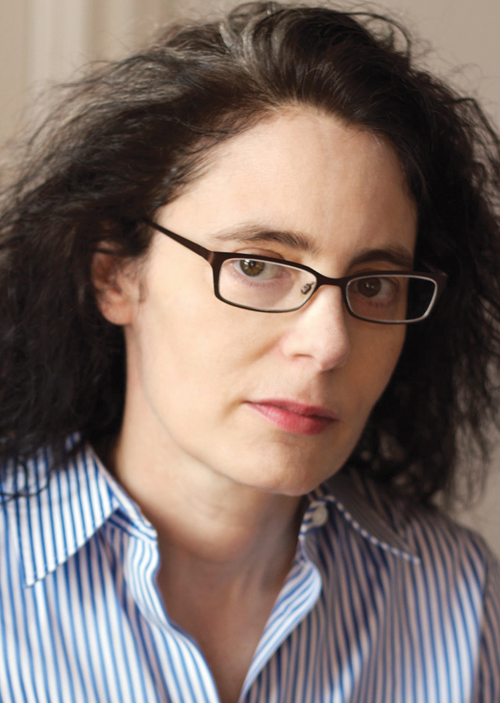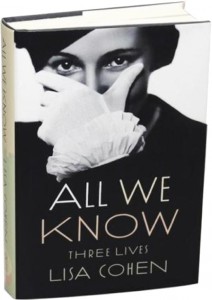The First Real L Word

‘All We Know: Three Lives’ reveals hot and heavy 1920s-era lesbian goings-on.
by Kit van Cleave
The 1920s was a fabled decade, an ongoing party filled with immense creativity produced by iconic artists in every field. In many cases, their rise to international celebrity and success was fueled by moneyed Americans, some of whom were newly rich.
But in a time of male hegemony, women were still limited by boundaries not of their own construction, and to step outside these boundaries could bring disaster and ostracism.
Lisa Cohen’s new book, All We Know, details the lives of three lesser-known gay women—two very rich and one not—who contributed to the style of the 1920s and for decades after. Needless to say, they had to hide; all married at least once, though inherited money protected them in the beginning.
Cohen’s longest section in the book describes Esther Murphy, a romantic in love with history and ideas. Six-foot-tall Esther was born into a very comfortable life, provided by her father’s purchase of Mark Cross, a leather goods company still patronized by the upper classes today. Esther was also noted as the sister of Gerald Murphy, who, with his wife Sara, moved to Paris in the expatriate 1920s.
On the French Riviera, the Murphys’ money and parties created around them a coterie of artists—Zelda and Scott Fitzgerald, Ernest Hemingway, John Dos Passos, Jean Cocteau, Pablo Picasso, John O’Hara, Cole Porter, and Dorothy Parker. Their mark on the decade is well documented; they invented sunbathing on the French beaches, they knew everybody, they entertained lavishly, and their money helped many young artists survive until their work caught on.
Gerald was at least bisexual, despite having fathered three children. Esther, his younger sister, created her own excitement back in New York with her precocious youthful talent for public speaking. She had a photographic memory and could quote at length; she was a fine debater, and in the early part of her adulthood, she wrote well. She also realized her romantic preference for women.
As one of the newly ascended Irish aristocracy, Esther attended the best schools in New York, and many of her classmates continued their friendships into adulthood. In 1921, her parents allowed her to go to Paris with one of them, and there they found Brearly School graduate Hope Williams had already linked into an affluent group of lesbians, including journalists Janet Flanner and Solita Solano, actress Katherine Cornell, Ziegfeld girl Peggy Frears, and Mercedes de Acosta, a fellow student at Sacred Heart Catholic School. ➝
“Many of these women traveled regularly between New York, London, and Paris. Esther herself was perpetually sailing to France during the 1920s,” Cohen notes. It makes sense; Gerald and Sara lived in France, but the biggest draw for Esther was Natalie Barney, the blonde American heiress worth millions, a notorious womanizer who sponsored a famed salon on Friday afternoons in her apartment at 20, rue Jacob. Every artist of the day was invited to eat and drink at Barney’s expense.
 Esther had always felt ungainly, due to her height, rather mannish face, large build, and awkward bearing. Still, her money, obvious brilliance, and eloquence made her a swan among these women, and she relished her place with them. But as the party rolled on, the hazards of drink began to take the best minds out of play. Addiction had become a national health hazard, and Ethel was a victim.
Esther had always felt ungainly, due to her height, rather mannish face, large build, and awkward bearing. Still, her money, obvious brilliance, and eloquence made her a swan among these women, and she relished her place with them. But as the party rolled on, the hazards of drink began to take the best minds out of play. Addiction had become a national health hazard, and Ethel was a victim.
“Decades of heavy drinking . . . [was] ruinous to her health and that of her friends. . . . It is hard to think of an American writer of the first half of the century, iconic or less known, whose life was not bound up with alcohol,” Cohen notes.
Through the years, Ethel’s obsession with writing a biography of Madame de Maintenon, intimate of King Louis XIV of France, seemed to be a result of her drinking. She became more interested in talking (and talking and talking) about the book than actually writing it.
How much of this waste of a great mind, and literary talent, was due to having too much money and no discipline to work? How much was due to her confusion about her homosexuality—never easy for a Catholic girl? How much was due to addiction? No one will ever know, as Esther died having never completed more than a chapter or two.
Beautiful writer and seductress Mercedes de Acosta was born in New York City to upper-class Spanish parents, and became arguably the first celebrity stalker. Her life started early with a fan-girl crush on Maude Adams, an actress known for her Peter Pan role in London. Eventually de Acosta would put her writing aside to pursue women all over the U.S. and Europe.
“Imagine being rowed across a pristine mountain lake in the Sierra Nevada by Greta Garbo. . . . Imagine having an admiring and aggressive Marlene Dietrich pounce on you, cook for you, inundate your house with flowers,” Cohen notes. Isadora Duncan said she would follow de Acosta “to the ends of the earth.” She was Dietrich’s “grand amour.” Eva Le Gallienne wrote to Mercedes that she would die if the dark seducer didn’t marry her.
Like Esther Murphy, de Acosta had been taught it demeaned rich daughters to do any kind of work. So both lacked discipline and self-control. Mercedes’ adoration of beautiful women became an open secret in Manhattan society, in part because she was prone to brag about her current loves. Eventually, this drove many of them away, including Garbo.
The slim and chic Madge Garland was so stubborn with her affluent parents that she wouldn’t go to a top British school, choosing to leave home and become independent. Her career was marked by studious hard work, regardless of her current position. As a secretary at British Vogue, she dutifully ran the same errands à la The Devil Wears Prada, with a twist. The current editor of Vogue UK, Dorothy Todd, was a lesbian, and she desired Madge and promoted her.
The pair began to establish the magazine as an artistic beacon of modernism. They printed works by Virginia Woolf and her lover Vita Sackville-West, photographer Cecil Beaton, painter Marie Laurencin, and fashion designer Nicole Groult (whose clients included Sara Murphy and Dorothy Parker). Many of these women also saw each other at Natalie Barney’s Friday salons.
The new Vogue UK became quite popular, but publisher Condé Nast felt it was “too bohemian,” and wasn’t making enough money. He was also tired of Todd’s drinking and rumors of Sapphic goings-on in the office, so he fired both Todd and Garland. The rest of Garland’s tale is evidence of how someone can pick up and go on after a devastating loss. With a demanding work ethic, she slowly became a powerful commentator on European fashion as the editor of Vogue, head of the Royal Society of Arts, and an expert on clothing design and fabrics.
The lives of these three women, Cohen states, show gay people influencing the arts, in open relationships, carrying into the Mary Quant 1960s, when England led the world in innovative fashion design. Cohen quotes Susan Sontag’s Notes on Camp, suggesting these women’s lives were the double act of show and hide, the essence of style.
Kit van Cleave is a freelance writer living in Montrose. She has published in local, national, and international media.
All We Know: Three Lives
by Lisa Cohen
2012 • Farrar, Straus and Giroux
(us.macmillan.com)
448 pages, $30











Comments